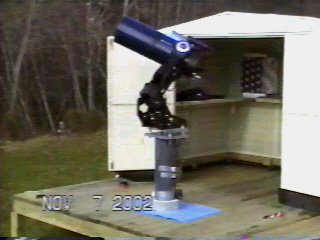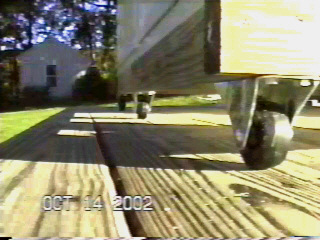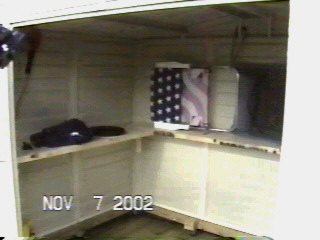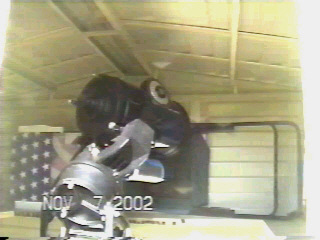Observatory
 Anyone
who has ever hauled out a big field tripod complete with
a heavy super wedge and then picked up a 75+ pound LX200
and fitted it onto the wedge finds out fairly quickly
that this is not something you want to be doing on a
regular basis. This is particularly true once the cold,
ice and snow set in. In the Summer of 2002, I purchased
my LX200 used on AstroMart, a great resource for amateurs
(ASTROMART
Classifieds). Setting it up
on warm Summer nights wasn't too bad, but I knew I'd need
a permanent spot for it before it got too cold.
Anyone
who has ever hauled out a big field tripod complete with
a heavy super wedge and then picked up a 75+ pound LX200
and fitted it onto the wedge finds out fairly quickly
that this is not something you want to be doing on a
regular basis. This is particularly true once the cold,
ice and snow set in. In the Summer of 2002, I purchased
my LX200 used on AstroMart, a great resource for amateurs
(ASTROMART
Classifieds). Setting it up
on warm Summer nights wasn't too bad, but I knew I'd need
a permanent spot for it before it got too cold.
I decided that a dome was the best way to go. Domes have
the edge in dew prevention, wind protection, and style. I
had a limited budget, and after looking at the pre-fab
domes, I gave up on the idea. A dome is really the way to
go, but since I couldn't afford one and I didn't have
confidence that I'd be able to make one myself before the
cold set in, I examined 2 other options: roll off roof
and roll back shed. The roll off roof seemed to me to be
potentially difficult to build, and is susceptible to dew
problems since it opens and exposes the interior
completely. The roll back shed offers -some- shelter from
dew and wind (not for the scope, but for charts,
computer, eyepieces, etc.) and has the added benefit of
being relatively easy to fabricate.
I completed my designs in September 2002 and by the end
of October, the building was complete. It makes a huge
difference! Using the big scope is now very easy and I
put a lot more time in than when I had to set it up each
night. Another benefit of having a permanent setup is
that the polar alignment can be set very accurately and
not lost in the setup - breakdown process.
Watch
amazed, as the observatory shed rolls back to reveal the
LX200!
Click Photo to
Begin
It's man powered, I push against the back (North) wall to
roll it back, and against the South side to return it
into home position. The whole thing weights less than 200
pounds and is very easy to move.
The shed rolls on 10 2.5" non-swivel casters, 3 each
on the East and West sides, one on either side of the
front doors, and 2 evenly spaced on the North side.
Pieces of black carpet protector were tacked along the
outside bottom of all sides to keep out the elements.



I built shelves around the East, North and West sides to
hold all my gear - it's key to have as little on the deck
as possible. The only thing I don't keep on the shelves
is the ETX70 which I place as close to the pier as
possible to prevent it from interfereing with opening and
closing the shed.
The LX200 fits snugly inside the shed, note that I must
turn it upside down to clear the door (you can see the
ETX90 and homemade dew shield under the LX200). I figured
the pier height based on the height of the shed, which is
not the same as the height of the door opening (d'oe!).
I've got about 4 inches of clearance, not enough for the
piggyback ETX90 so I flip it upside down. If I were to do
it again, I'd pour the pier 8" lower.
Click here for
more on observatory construction.
